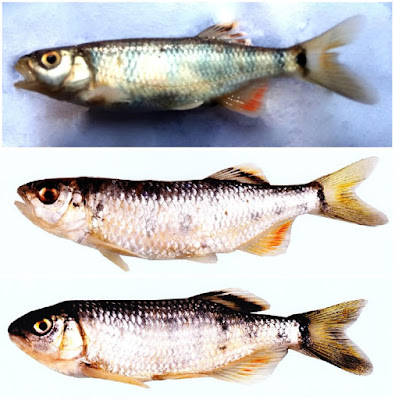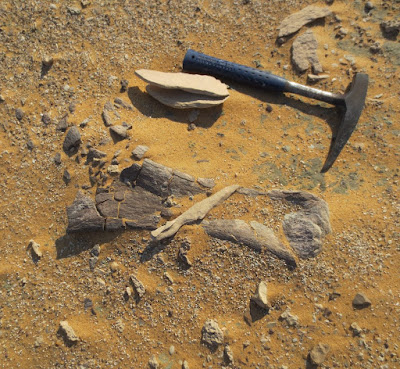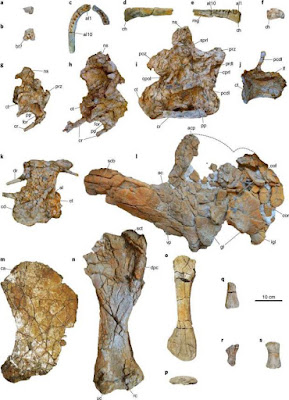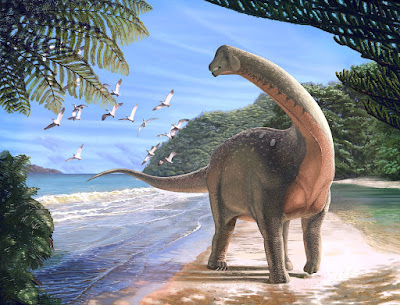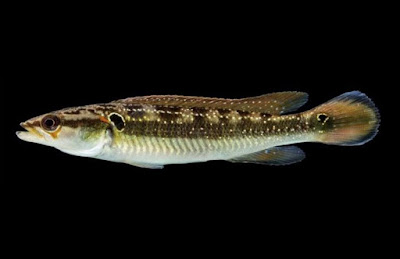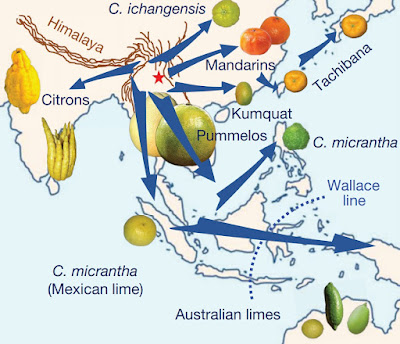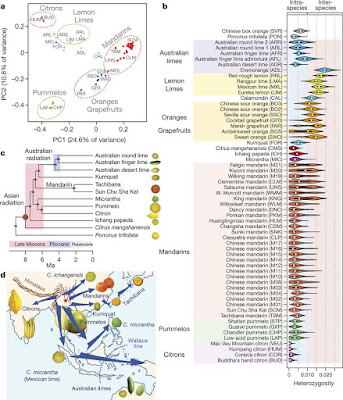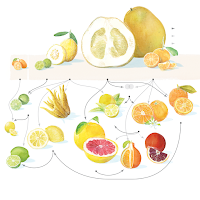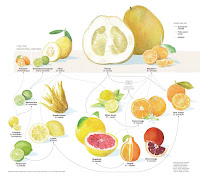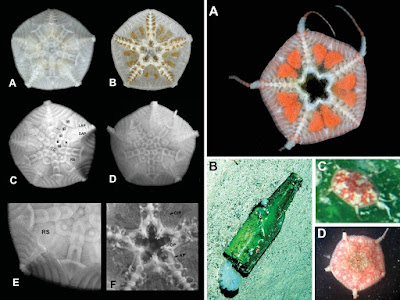[Most Recent Entries] [Calendar View]
Thursday, February 8th, 2018
| Time | Event | ||||||
| 4:44a | [Ichthyology • 2017] Opsarius kanaensis • A New Species of Bariliine Fish (Cypriniformes: Cyprinidae) from Manipur, Northeastern India
ABSTRACT Opsarius kanaensis is a new species from cyprinid fishes, Manipur. The new species is differentiated with other cyprinid fishes through the combination of morphological characters: 1 pair of short maxillary barbel, no mandibular knob, length of the origin of dorsal fin to the upper end of caudal fin lobe is longer than the distance between the origin of dorsal fin to the anterior margin of nares, 8-10 blue black lateral bands, a round blue black spot at the anterior base of caudal fin which is overlap by the last vertical band, a mid-transverse band of black colour in the dorsal fin, distinct red colouration of anal fin, depth of caudal peduncle 9.2-9.9% SL; eye diameter 6.3-8.5% SL; post dorsal length 72.1-78.5% SL; head length 18.7-24.2% SL; head depth at occiput 17.2-21.2% SL; and at eye 64.6-70.0% HL; snout length 30.8-37.2% HL; interorbital width 32.2-35.8% HL and width of head at neck 42.6-48.5% HL. A key to the species Opsarius from the Chindwin basin of Manipur is provided. Key words: Opsarius kanaensis, North eastern India, New species. Opsarius kanaensis new species Diagnosis Opsarius kanaensis, a new species of bariliine cyprinid fish is described from the Yu River basin of Manipur, north eastern India. The new species can be differentiated from its congeners occurring in the Chindwin basin of Manipur in having the following combination of characters:1pair of short rudimentary maxillary barbel, no mandibular knob, length of the origin of dorsal fin to the upper end of caudal fin lobe is longer than the distance between the origin of dorsal fin to the anterior margin of nares, 8-10 blue black lateral bands, a round blue black spot at the anterior base of caudal fin which is overlap by the last vertical band, a midtransverse band of black colour in the dorsal fin, distinct red colouration of anal fin, depth of caudal peduncle 9.2-9.9% SL; eye diameter 6.3-8.5% SL; post dorsal length 72.1-78.5% SL; head length 18.7-24.2% SL; head depth at occiput 17.2-21.2% SL; and at eye 64.6-70.0% HL; snout length 30.8-37.2% HL; interorbital width 32.2-35.8% HL and width of head at neck 42.6-48.5% HL. Habitat Opsarius kanaensis is found in fast-flowing stream and river with clear water, gravel or cobble bottoms (Figure 4). The new species O. kanaensisis accompanied with Schistura manipurensis, Pethia meingangbii; Glyptothorax granulus; Channa marulius; Rasbora ornatus; Devario aequipinnatus; Acanthocobitis zonalternans; Botia histronica etc. Distribution Opsarius kanaensisis at present is known only from the Kana River, a tributary headwater of the Yu River basin of Manipur (Figure 5). EtymologyThe species Opsarius kanaensis is named after the Kana River of Sajik-Tampak, located at Chakpikarong of Chandel District, Manipur. Arunkumar L. and Wanglar Alphonsa Moyon. 2017. Opsarius kanaensis A New Species of Bariliine Fish (Cypriniformes: Cyprinidae) from Manipur, Northeastern India. Species. 18(61); 160-169. | ||||||
| 4:45a | [Botany • 2017] Alphonsea glandulosa • A New Species (Annonaceae) from Yunnan, China Abstract Alphonsea glandulosa sp. nov. is described from Yunnan Province in south-west China. It is easily distinguished from all previously described Alphonsea species by the possession of glandular tissue at the base of the adaxial surface of the inner petals. Nectar was observed throughout the flowering period, including the pistillate phase and subsequent staminate phase. Small curculionid beetles were observed as floral visitors and are inferred to be effective pollinators since they carry pollen grains. A phylogenetic analysis was conducted to confirm the placement of this new species within Alphonsea and the evolution of the inner petal glands and specialized pollinator reward tissues throughout the family. Alphonsea glandulosa is unusual in the genus, however, in having multiple flowers (often 5 to 9) in each inflorescence. Although most Alphonsea species have inflorescences with only 1–4 flowers, there are two species, A. philastreana (Pierre) Finet & Gagnep. and A. ventricosa (Roxb.) Hook. f. & Thomson, which have more than four flowers per inflorescence. .... Alphonsea glandulosa Y.H. Tan & B. Xue, sp. nov. Diagnosis: Alphonsea glandulosa is unique amongst Alphonsea species in having a nectar gland at the base of the adaxial surface of each inner petal. It is most similar to A. philastreana (Pierre) Finet & Gagnep., but differs in having a greater number of secondary veins on each side of the leaf, greyish to yellowish pubescent flower buds, longer pedicels, a greater number of carpels per flower, a smaller number of ovules per carpel, and globose to shallowly bilobed stigmas. Etymology: The specific epithet reflects the presence of nectar glands at the base of the adaxial surface of each inner petal. Bine Xue, Yun-Yun Shao, Richard M. K. Saunders and Yun-Hong Tan. 2017. Alphonsea glandulosa (Annonaceae), A New Species from Yunnan, China. PLoS ONE. 12(2); e0170107. DOI: 10.1371/journal.pone.0170107 A New Species of Alphonsea Found in Xishuangbanna english.cas.cn/newsroom/research_news/20 | ||||||
| 4:47a | [Crustacea • 2018] Redescription of Parilia alcocki Wood-Mason, in Wood-Mason & Alcock, 1891 (Decapoda, Brachyura, Leucosiidae) from southeast India
Abstract Parilia alcocki Wood-Mason, in Wood-Mason & Alcock, 1891, the type species of Parilia Wood-Mason, in Wood-Mason & Alcock, 1891, described from the Bay of Bengal, is one of the largest known leucosioid crabs, reaching carapace widths of over 50 mm. It is, however, not well known and its male gonopods have never been figured. A series of specimens of this species obtained from a fishing port in Tamil Nadu, India, allows for a comprehensive re-description and illustrations of the species. Its distinguishing characters from congeners are discussed. Keywords: Crustacea, Deep-sea crab, Leucosioidea, Parilia alcocki, redescription, taxonomy M. Prema, S. Ravichandran and Peter K. L. Ng. 2018. Redescription of Parilia alcocki Wood-Mason, in Wood-Mason & Alcock, 1891 (Decapoda, Brachyura, Leucosiidae) from southeast India. Zootaxa. 4378(1); 111–120. DOI: 10.11646/zootaxa.4378.1.7 | ||||||
| 4:50a | [Paleontology • 2018] Mansourasaurus shahinae • New Egyptian Sauropod reveals Late Cretaceous Dinosaur dispersal between Europe and Africa
Abstract Prominent hypotheses advanced over the past two decades have sought to characterize the Late Cretaceous continental vertebrate palaeobiogeography of Gondwanan landmasses, but have proved difficult to test because terrestrial vertebrates from the final ~30 million years of the Mesozoic are extremely rare and fragmentary on continental Africa (including the then-conjoined Arabian Peninsula but excluding the island of Madagascar). Here we describe a new titanosaurian sauropod dinosaur, Mansourasaurus shahinae gen. et sp. nov., from the Upper Cretaceous (Campanian) Quseir Formation of the Dakhla Oasis of the Egyptian Western Desert. Represented by an associated partial skeleton that includes cranial elements, Mansourasaurus is the most completely preserved land-living vertebrate from the post-Cenomanian Cretaceous (~94–66 million years ago) of the African continent. Phylogenetic analyses demonstrate that Mansourasaurus is nested within a clade of penecontemporaneous titanosaurians from southern Europe and eastern Asia, thereby providing the first unambiguous evidence for a post-Cenomanian Cretaceous continental vertebrate clade that inhabited both Africa and Europe. The close relationship of Mansourasaurus to coeval Eurasian titanosaurians indicates that terrestrial vertebrate dispersal occurred between Eurasia and northern Africa after the tectonic separation of the latter from South America ~100 million years ago. These findings counter hypotheses that dinosaur faunas of the African mainland were completely isolated during the post-Cenomanian Cretaceous.
Hesham M. Sallam, Eric Gorscak, Patrick M. O’Connor, Iman A. El-Dawoudi, Sanaa El-Sayed, Sara Saber, Mahmoud A. Kora, Joseph J. W. Sertich, Erik R. Seiffert and Matthew C. Lamanna. 2018. New Egyptian Sauropod reveals Late Cretaceous Dinosaur dispersal between Europe and Africa. Nature Ecology & Evolution. DOI: 10.1038/s41559-017-0455-5 منصوراصورس facebook.com/HeshamSallam اكتشاف الديناصور المصري «منصوراصورس» https://www.scientificamerican.com/arabi | ||||||
| 5:38a | [Ichthyology • 2018] Crenicichla ploegi • A New Species of Pike-cichlid of the C. saxatilis Group (Teleostei: Cichlidae) from the Rio Juruena and upper Rio Paraguai Basins in Brazil, with An Updated Diagnosis and Biogeographical Comments on the Group
Abstract Crenicichla ploegi, new species, is described based on material from the Rio Juruena (Rio Papagaio, Rio do Sangue, Rio Arinos, and Rio Juruena itself) and from tributaries of the upper Rio Paraguai (upper Rio Jauru, upper Rio Cabaçal and upper Rio Sepotuba) in Mato Grosso, Brazil. Crenicichla ploegi is the twenty-third species of the C. saxatilis group. It is distinguished from all other species of the group by the presence of dark spots and vermiculations on snout, interorbital area and dorsally on head in adults vs. dark markings absent or present only in juveniles but absent in adults, and by the presence of a deep and strongly pigmented lateral band present in both juveniles and adults, occupying a depth of 4–6 horizontal scale rows vs. lateral band narrower, occupying a depth of 2–3 horizontal scale rows, and conspicuous only in juveniles and smaller specimens, faded or absent in larger specimens. Diagnostic characteristics of the C. saxatilis group proposed in previous studies were discussed to update the diagnosis of the group, and morphological comparisons among the species included in the group, with biogeographical comments, are provided. The presence of conspicuous dark markings dorsally on the head and the presence of a prominent midlateral band are hypothesized to be paedomorphic characteristics, retained from juvenile conditions in the context of the species of the C. saxatilis group. Keywords: Pisces, biogeography, coloration, paedomorphy, species groups
Distribution: Crenicichla ploegi is known both from the upper Rio Paraguai basin, and from tributaries of the upper Rio Juruena, in Mato Grosso state, Brazil. Etymology: Crenicichla ploegi is named in honor of the Dutch ichthyologist Alex Ploeg, whose PhD thesis dealt with the taxonomic revision, biogeography and phylogeny of Crenicichla, and who published papers on systematics of the genus from 1986 to 1991, describing a total of 23 species, 18 of which still considered to be valid. Since then, he worked as interlocutor between the ornamental fish industry and other institutions worldwide. Unfortunately, Dr. Ploeg perished with his wife and son in the Malaysia Airlines 17 (MH17) airplane attack in Ukraine on 17 July 2014. Habitat and ecological notes: Crenicichla ploegi has been collected in a variety of aquatic habitats, but mostly in streams and mid-sized rivers. The type locality is actually an exception, being a large river pool, more than 100 meters wide. Streams and rivers inhabited by C. ploegi possess clear water, a moderate to fast water flow, and rocky bottoms, usually with well-developed riparian forest, although the species has also been collected in rivers with highly disturbed or suppressed riparian forest.
Henrique R. Varella, Marina V. Loeb, Flávio C.T. Lima and Sven O. Kullander. 2018. Crenicichla ploegi, A New Species of Pike-cichlid of the C. saxatilis Group from the Rio Juruena and upper Rio Paraguai Basins in Brazil, with An Updated Diagnosis and Biogeographical Comments on the Group (Teleostei: Cichlidae). Zootaxa. 4377(3); 361–386. DOI: 10.11646/zootaxa.4377.3.3 | ||||||
| 5:52a | [Botany • 2018] Genomics of the Origin and Evolution of Citrus
Abstract The genus Citrus, comprising some of the most widely cultivated fruit crops worldwide, includes an uncertain number of species. Here we describe ten natural citrus species, using genomic, phylogenetic and biogeographic analyses of 60 accessions representing diverse citrus germ plasms, and propose that citrus diversified during the late Miocene epoch through a rapid southeast Asian radiation that correlates with a marked weakening of the monsoons. A second radiation enabled by migration across the Wallace line gave rise to the Australian limes in the early Pliocene epoch. Further identification and analyses of hybrids and admixed genomes provides insights into the genealogy of major commercial cultivars of citrus. Among mandarins and sweet orange, we find an extensive network of relatedness that illuminates the domestication of these groups. Widespread pummelo admixture among these mandarins and its correlation with fruit size and acidity suggests a plausible role of pummelo introgression in the selection of palatable mandarins. This work provides a new evolutionary framework for the genus Citrus. Guohong Albert Wu, Javier Terol, Victoria Ibanez, Antonio López-García, Estela Pérez-Román, Carles Borredá, Concha Domingo, Francisco R. Tadeo, Jose Carbonell-Caballero, Roberto Alonso, Franck Curk, Dongliang Du, Patrick Ollitrault, Mikeal L. Roose, Joaquin Dopazo, Frederick G. Gmitter, Daniel S. Rokhsar and Manuel Talon. 2018. Genomics of the Origin and Evolution of Citrus. Nature. DOI: 10.1038/nature25447 The Citrus Family Tree on.natgeo.com/2AQGWMo @NatGeoMag | ||||||
| 10:46a | [Invertebrate • 2018] Astrophiura caroleae • A New Species of the Remarkable Brittle Star Genus Astrophiura (Echinodermata: Ophiuroidea) from the western Atlantic Ocean
Abstract Astrophiura caroleae, new species, is described from off Curacao in the southern Caribbean, and from the western Gulf of Mexico, in depths of 244 to 434 meters. This new species, the first in the genus Astrophiura to be described from the Atlantic Ocean, has a distinctive combination of characters, including regularly arranged primary plates, large radial shields whose radial edges are in contact for their entire visible length, and prominent tubercles on central and radial plates. The mottled reddish coloration of the dorsal surface of this species usually contrasts with the color of the substratum, rendering it readily visible in situ, despite its disc diameter of less than 10 mm. Like its congeners, A. caroleae is gonochoric, the gonads of females containing conspicuous masses of bright orange eggs that are approximately 165 µm in diameter. DNA Barcoding data are provided for this new species, these are the first for Astrophiura. Keywords: Echinodermata, Ophiuroidea Class Ophiuroidea Superorder Euryophiurida O’Hara et al., 2017 Order Ophiurida sensu O’Hara et al., 2017 Family Astrophiuridae Sladen, 1879 Diagnosis. Ophiurids in which enlarged proximal lateral arm plates form the margin of the disc. (Partly after O’Hara, 2017). Remarks. The paedomorphic (Stöhr and Martynov, 2016) ophiuroid genus Astrophiura has long been placed in the family Ophiuridae. Hugall et al. (2015) noted that Astrophiura is related to Ophiomisidium and Ophiophycis. Then O’Hara et al. (2017) followed the recommendation of Vadon (1990) and formally resurrected the family Astrophiuridae, noting in their Table 4 (p. 422) that the family contains 22 species (presumably Ophiomisidium with eight species; Ophiophycis, seven species; and Astrophiura, approximately seven species; data derived from the World Ophiuroidea Database—Stöhr et al. 2017).
Astrophiura caroleae new species Diagnosis. Astrophiura with disc regularly pentagonal, up to 10 mm in diameter, interradial margins convex. Free portions of arms slightly shorter than disc diameter. In dorsal disc, elongated diamond-shaped radial areas higher than interradial areas. Conspicuous ossicles in dorsal disc include central plate, infrabasals, basals, and radials, three or four interradial plates, the distalmost approximately triangular with a sharp distal point, and large radial shields, pairs of which are contiguous for their entire length. Most plates smooth, but central and radial plates have a single prominent central tubercle, and each radial shield has a more or less conspicuous prominence near the distal edge. Proximal dorsal arm plates on the disc are quadrangular, wider than long. Six or seven oral papillae on each jaw. Adoral plates elongate, visible portions at least 6 times as long as wide, the proximal ends of each pair abutting more or less in line with the apex of each jaw. Color in life variegated brownish to reddish with whitish patches, the tubercles on dorsal plates usually lighter in color than surrounding areas. Etymology. It is a pleasure to name this species for Dr. Carole Baldwin, Chair of the Vertebrate Zoology Department, National Museum of Natural History, Smithsonian Institution. Dr. Baldwin founded the Smithsonian’s Deep Reef Observation Project (DROP) in 2011 and she has inspired its steady growth in addition to conducting her own excellent research on fishes. Preferred Habitats: It is well-known that Astrophiura prefers a hard substratum; individuals can be found attached to dead mollusk shells (Fujita and Hendler, 2001), and rocks (Ziesenhenne, 1951; Matsumoto, 1917). A. caroleae was first observed attached to a discarded Heineken beer bottle, where its reddish coloration contrasted sharply with the green of the bottle. Other specimens were collected from miscellaneous bottles near the type locality Distribution: This species is known from off Curacao in the southern Caribbean, and also from off Quintana Roo, Mexico, in depths of 244 to 434 meters. David L. Pawson. 2018. A New Species of the Remarkable Brittle Star genus Astrophiura (Echinodermata: Ophiuroidea) from the western Atlantic Ocean. Zootaxa. 4378(2); 257–264. DOI: 10.11646/zootaxa.4378.2.4 |
| << Previous Day |
2018/02/08 [Calendar] |
Next Day >> |
